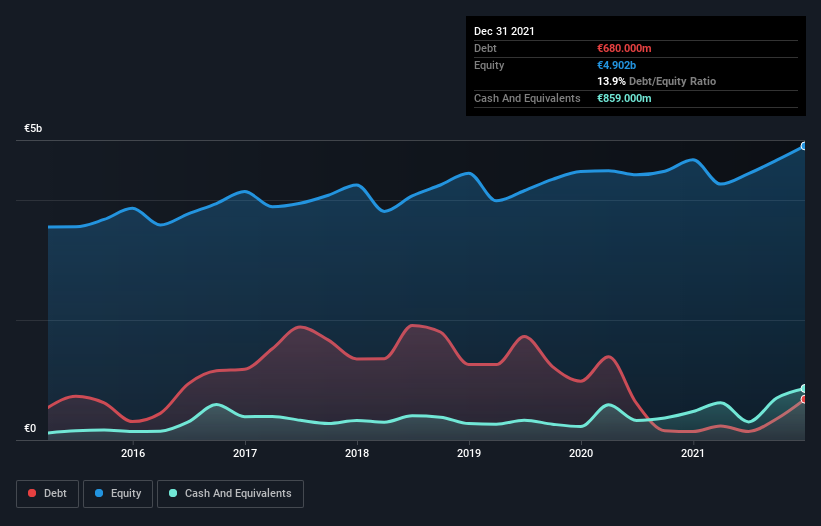- Netherlands
- /
- Professional Services
- /
- ENXTAM:RAND
These 4 Measures Indicate That Randstad (AMS:RAND) Is Using Debt Safely

The external fund manager backed by Berkshire Hathaway's Charlie Munger, Li Lu, makes no bones about it when he says 'The biggest investment risk is not the volatility of prices, but whether you will suffer a permanent loss of capital.' So it seems the smart money knows that debt - which is usually involved in bankruptcies - is a very important factor, when you assess how risky a company is. We note that Randstad N.V. (AMS:RAND) does have debt on its balance sheet. But the more important question is: how much risk is that debt creating?
Why Does Debt Bring Risk?
Debt and other liabilities become risky for a business when it cannot easily fulfill those obligations, either with free cash flow or by raising capital at an attractive price. In the worst case scenario, a company can go bankrupt if it cannot pay its creditors. However, a more usual (but still expensive) situation is where a company must dilute shareholders at a cheap share price simply to get debt under control. Of course, plenty of companies use debt to fund growth, without any negative consequences. When we think about a company's use of debt, we first look at cash and debt together.
See our latest analysis for Randstad
What Is Randstad's Net Debt?
As you can see below, at the end of December 2021, Randstad had €680.0m of debt, up from €141.0m a year ago. Click the image for more detail. However, it does have €859.0m in cash offsetting this, leading to net cash of €179.0m.

How Healthy Is Randstad's Balance Sheet?
We can see from the most recent balance sheet that Randstad had liabilities of €4.79b falling due within a year, and liabilities of €1.35b due beyond that. Offsetting these obligations, it had cash of €859.0m as well as receivables valued at €5.24b due within 12 months. So its total liabilities are just about perfectly matched by its shorter-term, liquid assets.
Having regard to Randstad's size, it seems that its liquid assets are well balanced with its total liabilities. So it's very unlikely that the €11.1b company is short on cash, but still worth keeping an eye on the balance sheet. While it does have liabilities worth noting, Randstad also has more cash than debt, so we're pretty confident it can manage its debt safely.
Even more impressive was the fact that Randstad grew its EBIT by 112% over twelve months. If maintained that growth will make the debt even more manageable in the years ahead. There's no doubt that we learn most about debt from the balance sheet. But it is future earnings, more than anything, that will determine Randstad's ability to maintain a healthy balance sheet going forward. So if you want to see what the professionals think, you might find this free report on analyst profit forecasts to be interesting.
Finally, a business needs free cash flow to pay off debt; accounting profits just don't cut it. Randstad may have net cash on the balance sheet, but it is still interesting to look at how well the business converts its earnings before interest and tax (EBIT) to free cash flow, because that will influence both its need for, and its capacity to manage debt. Over the last three years, Randstad actually produced more free cash flow than EBIT. There's nothing better than incoming cash when it comes to staying in your lenders' good graces.
Summing up
We could understand if investors are concerned about Randstad's liabilities, but we can be reassured by the fact it has has net cash of €179.0m. And it impressed us with free cash flow of €782m, being 139% of its EBIT. So we don't think Randstad's use of debt is risky. When analysing debt levels, the balance sheet is the obvious place to start. However, not all investment risk resides within the balance sheet - far from it. For example, we've discovered 1 warning sign for Randstad that you should be aware of before investing here.
At the end of the day, it's often better to focus on companies that are free from net debt. You can access our special list of such companies (all with a track record of profit growth). It's free.
New: AI Stock Screener & Alerts
Our new AI Stock Screener scans the market every day to uncover opportunities.
• Dividend Powerhouses (3%+ Yield)
• Undervalued Small Caps with Insider Buying
• High growth Tech and AI Companies
Or build your own from over 50 metrics.
Have feedback on this article? Concerned about the content? Get in touch with us directly. Alternatively, email editorial-team (at) simplywallst.com.
This article by Simply Wall St is general in nature. We provide commentary based on historical data and analyst forecasts only using an unbiased methodology and our articles are not intended to be financial advice. It does not constitute a recommendation to buy or sell any stock, and does not take account of your objectives, or your financial situation. We aim to bring you long-term focused analysis driven by fundamental data. Note that our analysis may not factor in the latest price-sensitive company announcements or qualitative material. Simply Wall St has no position in any stocks mentioned.
About ENXTAM:RAND
Randstad
Provides solutions in the field of work and human resources (HR) services.
Undervalued with excellent balance sheet.


